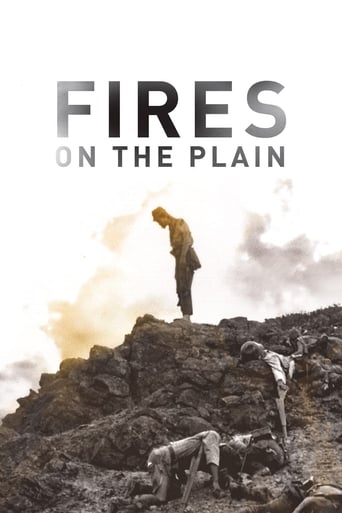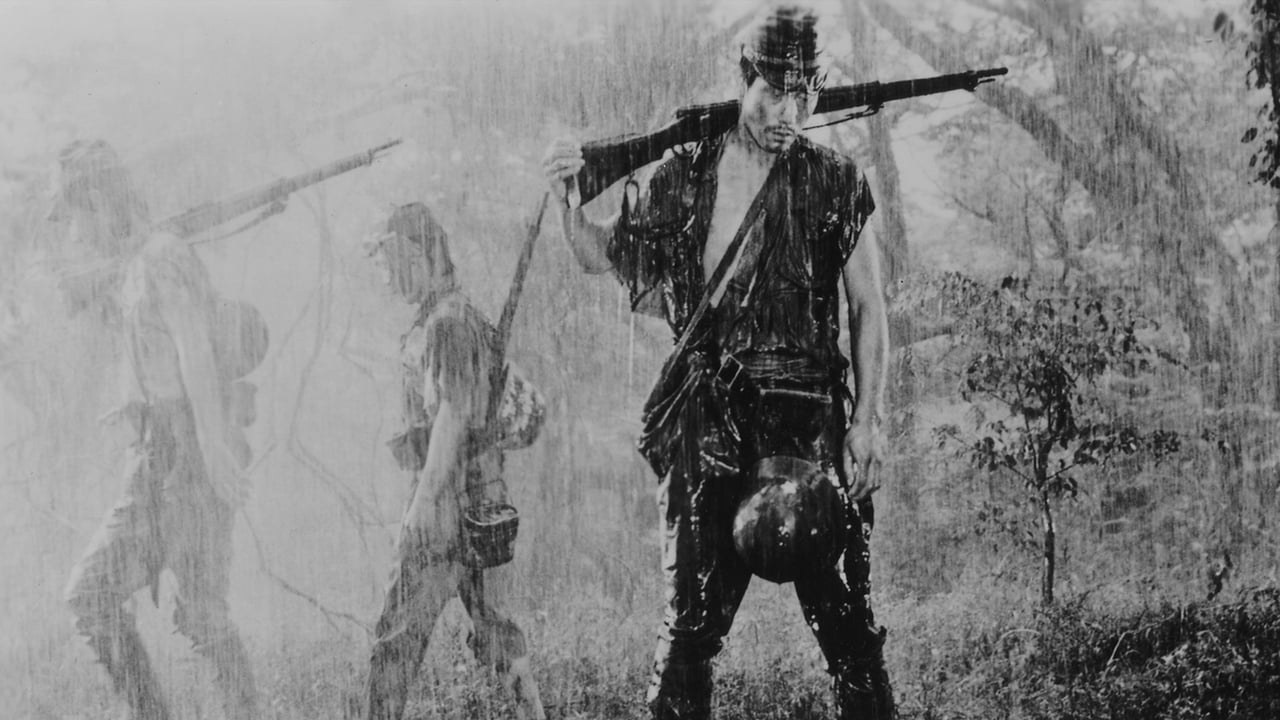museumofdave
So few films deserve the designation of "Masterpiece" For me, this finely-honed, abrasive immersion in war is one of the few. It is brutal and unrelenting, it is bluntly sincere in intent, and brilliantly depicts the depths of degradation the human condition can reach when immersed in the killing fields.Fires On The Plain is, in no way, a pleasant film, and if you're one who desires a "good guys versus bad guys" with a triumphant ending, look elsewhere. Director Ichikawa has seen first-hand the results of mass killing, and his bleak black-and-white composition stands as a persuasive caution to those who still believe in the brutality of battle to solve man's continuing hostility to his own kind--that the acting is consistently compelling and the photography stunning does not detract from the ultimate message. Not recommended as entertainment of a light kind, but as a compelling vision of a holocaust.
Hitchcoc
When we think of the John Wayne type of World War II film, we think of a group of autonomous soldiers, driven to achieve their missions. They lose men along the way; the ways of battle take their toll. But they are usually clean, well fed, and healthy. I know from watching documentaries about this war that both American and enemy soldiers did not always have this luxury. Sometimes the cost of war was infection, starvation, and injury. There wasn't always a clean, decisive end to these maladies. This is a film which is from the Japanese perspective. The army is already in disarray, starving, full of disease, but still forced to continue its mission in Leyte. They have been defeated, but their adversaries don't know that and continue to shell them and attack them from superior positions. These soldiers are, once again, pawns of a government, lustful for power, making them expendable. This is the film equivalent of a man hanging on a cliff, hoping for one more hour of life. Around him are similar people who have turned to pillaging, killing their comrades, and, yes, even cannibalism. They are stick men, barely casting shadows in the sewage they inhabit. They share salt or kill for it. This is a hard film to watch, but anyone who does should be aware of the costs of war. Brilliantly filmed and produced.
ebossert
Yet again, I appear to be the only person on planet Earth who is capable of criticizing Japanese films made before 1970. "Fires on the Plain" (1959) is another in the seemingly endless line of "classics" that get all sorts of praise for no apparently good reason. As much as I love to overgeneralize and psychoanalyze all of these moviegoers who have such horrible taste in film, it's still nearly impossible to rationalize why anyone would ever think that poorly made fluff like this should be proclaimed as some sort of "masterpiece." What I find truly ironic is that fans of derivative "classics" like "Fires on the Plain" focus so much on "inside the box" movie-making (orthodox grading standards like scriptwriting, acting, camera-work, etc.) yet it always seems like the most highly revered "classics" are most deficient in these very standards. For example, one of the laziest copouts for a filmmaker involves forced verbal exposition where characters basically explain everything for the viewer even when the constructed scenario is totally artificial. Most surprisingly, the very first scene in "Fires on the Plain" uses this indolent tactic to the extreme.After a funny head slap, the following useless dialogue assaults the viewer, "Why can't you grasp the situation? We landed to the west under heavy fire to reinforce units at Tacloban. We lost two-thirds of our men. Our artillery was sunk in transit. We tried to reach Burauen airfield by crossing the central mountains but without artillery it was impossible. The enemy's counterattack forced a fanout across the valley. You know that." So why, exactly, is one character telling another character something he already knows? Oh yeah, that's right, the makers of this film are too lazy to think of more natural ways to communicate this information. You see, a quality film would actually show these events happening, or at worst it would involve dialogue involving one character who has no knowledge of those events. Heck, even an opening summary in paragraph form directed at the viewer would have been better than what transpired here.Such instances of poor quality movie-making are littered throughout "Fires on the Plain" to the point where this film feels like it was written by imbeciles for imbeciles. For example, the lead character stumbles upon some skeletons wrapped in Japanese garb. Instead of doing the natural thing like – oh I don't know – giving a depressed mannerism, the character blurts out "Japanese soldiers." Thanks buddy, but I could have figured that one out for myself.Even worse, this movie is saturated with over-dramatic ploys. The most ridiculous scene involves a pair of boots. Picture this. A soldier walks along and finds a pair of worn out boots. One would think that such a find is utterly useless, but it turns out that the soldier's boots are in even worse condition, so he picks up the worn boots and leaves his SUPER worn boots behind. Fine, I get the point. The soldiers are in rough shape – a fact that is already clearly emphasized with their worn boots to begin with. The scene is ridiculous, but I was ready to let it go, until the SECOND soldier arrives! You see, he finds the previous soldier's SUPER worn boots and notices – get ready, cause here it comes – that his boots are SUPER DUPER worn boots! Lucky man, he picks up the SUPER worn boots and leaves his SUPER DUPER worn boots behind. But you see, that's not all – because the THIRD soldier then arrives! He finds the previous soldiers SUPER DUPER worn boots and inspects them, along with his own SUPER DUPER worn boots. Since both pairs suck, he tosses them both aside and smiles as he continues barefoot. At this point I was ready to throw my television through my living room window. The heavy handedness, overdramaticism, and paramount absurdity of this sequence is beyond bad film-making. It's SUPER DUPER bad film-making.There are a number of similar, completely stupid moments to be had. Like the time when the lead character asks someone, "Hey, are you dead?" Like the guy is going to answer "Yes" if he actually kicked the bucket. I'll also be the first to condemn the subpar performance of the lead actor, who is the quintessential posterchild for artificial reaction. I laughed hard during that opening head slap where his head slingshot back in place with this stupid, goofy expression on his face.The fact that this trivial fluff piece gets an IMDb average rating of 8.4 while a certifiable masterpiece like "A Tale of Two Sisters" (2003) only gets a 7.5 is the height of mass stupidity. And to think that some people actually delude themselves into thinking that "AToTS" doesn't make sense. Well, not every movie can have completely outrageous SUPER DUPER worn boots on its side.
MacAindrais
Fires on The Plain (1959) ****You don't see films like this anymore. 'Fires on the Plain' is an incredible depiction of the lives of the soldiers of the Japanese Imperial Army. Kon Ichikawa's masterpiece follows Tamura, a soldier with Tuberculosis as he wanders around the Philippine landscape in the last year of the war. He is sent away to the hospital by his commanding officer only to be refused treatment and so he is sent back. His CO tells him to go back and if they refuse him again then his last order is to kill himself with his grenade. He is refused again, but meets up with a band of squatters sitting outside the hospital. The next day they are shelled by American troops and Tamura flees, choosing not to kill himself, and from there he wanders from place to place trying to get to Palompon. He discovers that some men have been eating human flesh in order to survive, while others trade as much tobacco as they can for whatever they can get back.The film is filled with a quiet sense of desperation and desolation, with a hint of insanity. Everyone we see is skin and bones, covered in dirt wearing torn and tattered rags. Ichikawa uses his camera to catch some beautiful shots of the destructed landscape and the Japanese soldiers who walk it. Kon Ichikawa was famous in Japan for making many comedies and satires, and there are moments in Fires on the Plain that are bitingly hilarious. Take for example a shot of what appears to be a dead man lying face down in a pool of water; a soldier walks but and asks himself aloud if that is how they will all end up, to which the man lifts his head out of the water and replies "what was that?" and then drops his face even deeper into the puddle than before. Another hilarious sequence involves one man finding a pair of boots along the trail. He takes the boots, replacing them with his old ones. Another man walks by and sees that pair of boots and switches up for his old boots. The scene continues until finally Tamura finds the exchange spot and examines the boots left without hardly any sole. He looks carefully at his own and at ones on the ground, and deciding that they're both kaput he removes his own and goes barefoot. The film is filled with incredible scenes, one after another. Like Mizoguchi and Kurosawa, Ichikawa knew how to use his camera to paint beautiful and stunning pictures. There are many stunning shots of men in barren empty plains surrounded by nothing but smoke in the air and dead or dying bodies on the broken earth. There is another incredible scene where dozens of Japanese soldiers attempt to cross a road guarded by Yanks in the middle of the night, all crawling on their hands and knees as the camera watches on from above. The film gets its name from the columns of smoke rising up from fires on the plains seen throughout the film. They represent to the soldiers life a little more ordinary; the lives of Japanese farmers back home burning husks of corn. Their beacons of hope for the normal life however are in hostile hands.The film caused a stir in its day with its graphic content. Much emphasis is placed on the horror of war, not just with the enemy but within your ranks and yourself. Kon Ichikawa's Fires on the Plains is an incredibly authentic and moving, and somewhat disturbing, portrait of the horror suffered by the men making up the lower ranks of the Imperial Army. Clint Eastwood's Letters From Iwo Jima, while it is a very good film, comes nowhere close to realizing the horror of war depicted in Fires on the Plain. (Eastwood was no doubt influenced by the film, seeing as he claims to be such a classic Japanese film buff.) Many war films show that war is hell through the eyes of the winners. In Fires on the Plain, we're shown that war is even more hellish when you're on the losing end 4/4


 AD
AD



